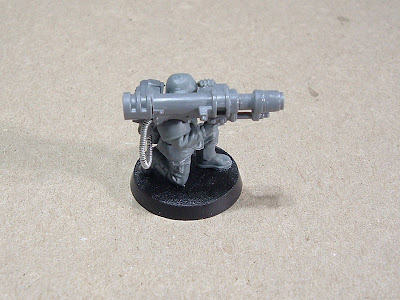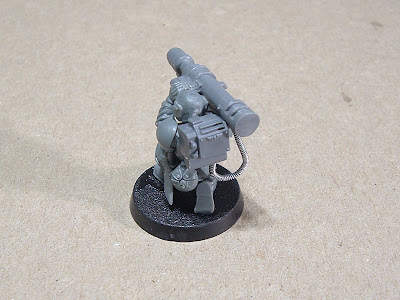Introduction
I was watching Aliens again, and there’s a scene where Hudson is being obnoxious, and the phrase “phased plasma gun” piqued my interest. I immediately went to consult Professor Google on the subject, and after several different search queries, I finally chanced upon some online excerpts and scanned images from the Colonial Marines Technical Manual for something called a M78 PIG. This Plasma Infantry Gun, it turns out, looks exactly like a conventional shoulder-fired missile launcher with a separate power pack. Now that’s something we can do with the leftover bits in the Cadian boxed sets!
According to what I’ve read, the PIG is basically the BFG 9000 of the Aliens setting. When this particular pig oinks, something explodes spectacularly. So, it’s definitely something we want to add to our little arsenal for antimateriel punch.
I didn’t want to just run a cable from the normal missile launcher to some converted power pack because, well, it’d look like a normal missile launcher attached to a power pack. This is fine for cinema, but not for miniature wargaming. People acquainted with Warhammer 40,000 generally already know what an Imperial Guard missile launcher looks like, and if we left the missile launcher as-is, people would automatically think “missile launcher” when they look at it. So, we want to change the way it looks a bit.
I decided I wanted to make it look a little bit more like a gun than a missile launcher, while still retaining the overall form factor of a tube-shaped shoulder-fired weapon. Looking through the leftover bitz, I found that the autocannon and lascannon remnants would do a nice job of changing the silhouette of the weapon, and the leftover voxcaster halves from the Sentry Gun conversions would make great power packs with a little work.
Required Parts
The photo below illustrates the parts needed for this conversion. When only a small portion of a part is required, the important piece is highlighted in red. (Save the leftover pieces! They’ll come in handy later.)
The photos below show how all the parts listed above go together to assemble a PIG.
- Slice off the front section of the missile launcher right in front of where it meets the sight. The “ring” that the sight is attached to and the handgrip assembly both form a nice guiding line all around the tube to use as a cutting guide.
- Slice off the rear section of the missile launcher, from the very back of the shoulder rest.
- Carefully slice the longest barrel section off the autocannon barrel segment, leaving only the “ring” and two short tubes. Be careful doing this, as you need both pieces in usable condition.
- Clean up and trim the 2-tube segment of the autocannon barrel so that each tube is about 3mm long. Glue that to the front of the missile launcher body.
- Slice off the tube-like cap on the front of the missile launcher blast shield. Make sure the back of the cap is nice and even.
- Glue the blast shield cap to the front of the autocannon barrel segment attached to the missile launcher body.
- Slice the muzzle off the lascannon barrel. Remove the angled segment so that the muzzle is flat on both ends.
- Glue the lascannon muzzle segment to the back of the missile launcher body, with the grooves facing up.
- Glue the finished PIG to the normal missile launcher arm and set it aside to dry.
Power Pack Assembly
- Remove the remaining aerials from the voxcaster pack, and slice off the speaker assembly on its right side. This will leave a roughly 45 degree bevel along the upper right side of the pack, so clean and shave that area until it looks natural. Essentially, you want to make sure the bevel is nice and even along the whole edge. This forms the upper half of the power pack.
- Slice off the little box on the left side of the voxcaster pack, and shave the side down flat.
- Align the longer autocannon barrel segment with the bottom of the voxcaster pack, then trim and shave it so that it is the same width as the voxcaster pack. This will form the bottom half of the power pack.
- Glue the trimmed barrel segment to the bottom of the voxcaster pack, and test the power pack’s fit on a loose Cadian torso to make sure it seats properly.
Power Cable Assembly (Optional)
- Take 2 lengths of soft metal craft wire, one of a thinner diameter than the other. Hold them together side by side, then twist the thinner wire tightly around the thicker wire. Continue twisting until you have approximately 26mm of ribbed cable. (Note: this process is very quick if you have a pin vise handy. Simply insert both wires into the chuck, tighten it, then twist the pin vise while holding the thin wire perpendicular to the thick wire.)
- Snip the cable out, leaving approximately 3mm of the core wire protruding from each end.
- Using a drill bit of equivalent thickness to the core wire, drill one hole in the back of the PIG’s shoulder rest and another hole on the bottom right of the power pack.
Figure Assembly
- Assemble the figure’s base, legs, and torso only.
- You will need to shave off the boxlike protrusion on the back of the figure’s helmet.
- Glue the power pack to the figure’s back, then glue the head into place.
- Glue the right arm to the figure. Note that the right arm may need to be gooshed around just a little bit, as the missile launcher wasn’t designed to be used with a backpack.
- Glue the left arm to the figure, making sure you add a little dab of glue to the underside of the left hand’s fingers. (This will be attached to the sighting unit.)
- After the glue has set, bend and twist the power cable so that it fits on the PIG and its power pack nicely.
- Apply a dab of superglue gel (cyanoacrylate adhesive) to each hole, then insert the power cable permanently.
Consult the photos below for clarification on where to drill the holes for the power cable, and how to install it so that it sags nicely:


You’re done! Repeat this one more time, and you’ll have a pair of PIGs.
















